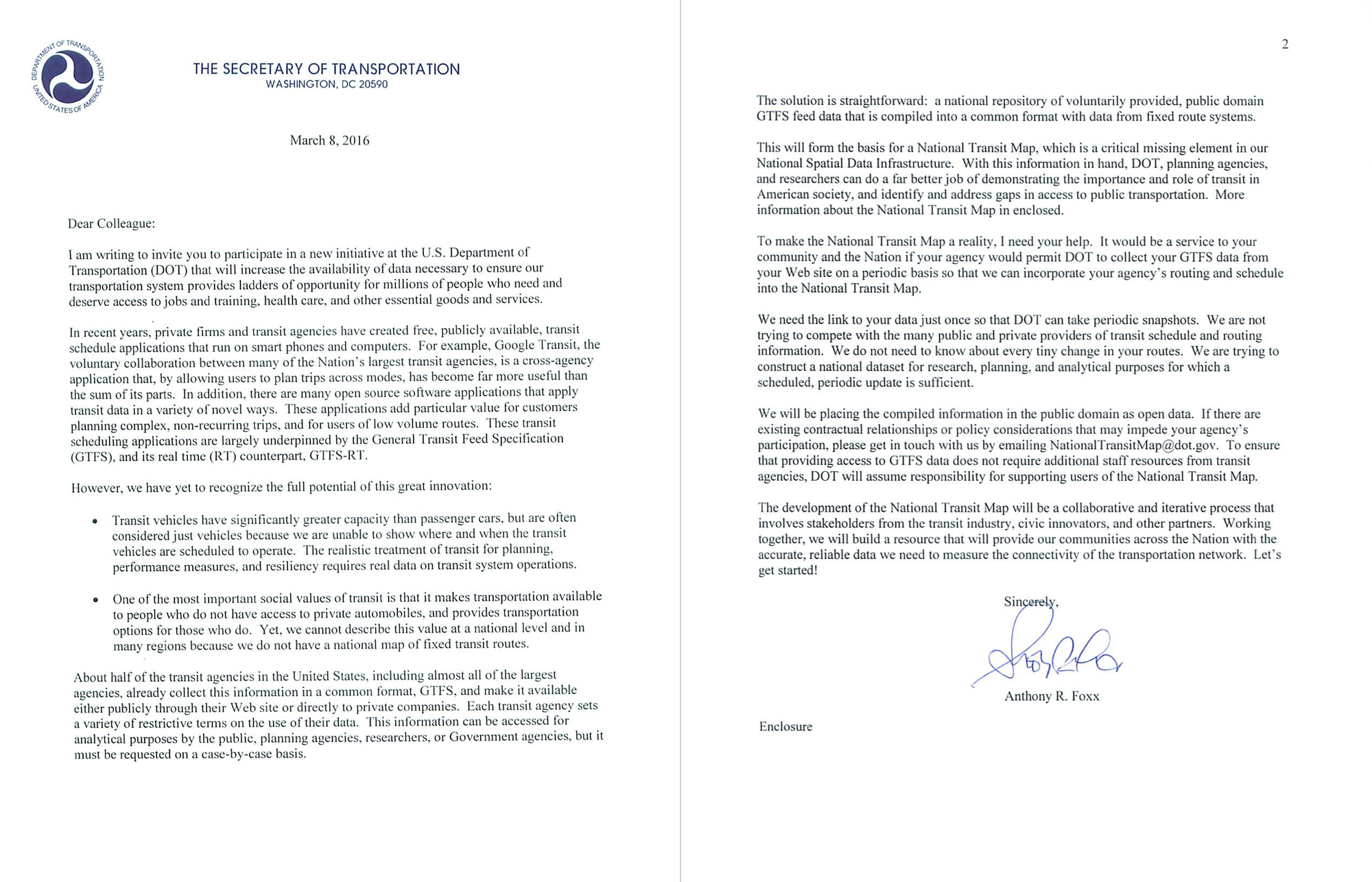The US National Transit Map is a set of GIS layers available as part of the National Transportation Atlas Database (NTAP). Learn the history of the National Transit Map and how it compares in data coverage and functionality with Transitland.
Brief History of the US National Transit Map
Many public transit agencies across the United States have been producing GTFS data feeds for years. Some regional governments and state governments have also been involved in producing and disseminating GTFS data, on behalf of the transit agencies in their areas of interest. But the US federal government had no involvement in encouraging the production of GTFS feeds or helping to disseminate GTFS data.
The US federal government became involved in GTFS data in 2016 when Secretary of Transportation Anthony Foxx issued a “dear colleague” letter announcing:
The solution is straightforward: a national repository of voluntarily provided, public domain GTFS feed data that is compiled into a common format with data from fixed route systems.

Since that announcement, the Bureau of Transportation Statistics (BTS), within the US Department of Transportation (USDOT), has been tasked with creating and maintaining the National Transit Map.
How does the National Transit Map collect GTFS feeds?
Transit agencies opt-in to participating in the National Transit Map:
- Transit agency staff voluntarily submit URLs for their static GTFS feeds to the Federal Transit Administration (FTA) using the FACES website.
- Transit agency staff grant USDOT use of their static GTFS feeds under the Creative Commons Attribution 3.0 United States (CC-BY-3.0) license.
- FTA shares the list of submitted static GTFS feed URLs with the Bureau of Transportation Statistics (BTS).
- Transit agencies continue to update their static GTFS feeds on a regular basis at the same stable URLs.
- Several times a year, BTS staff download copies of the static GTFS feeds that have been submitted for inclusion.
This process may change in the future. As of late 2022, the Federal Transit Administration is considering making the submission of GTFS feed URLs mandatory as part of the US National Transit Database (NTD) reporting process for transit agencies that receive federal funds for fixed-route transit.
What data is available from the National Transit Map?
The US Bureau of Transportation Statistics downloads agencies’ static GTFS feeds a few times each year and uses the source feeds to produce nation-wide geospatial layers in the National Transportation Atlas Database (NTAD). The collected GTFS source data is not released to the public.
As of early 2023, three layers are available as part of the National Transit Map:
- agencies: point geometries for 520 transit agency’s headquarters along with some metadata about each agency
- stops: point geometries for 467,637 transit stops and a subset of the metadata available about stops in the source GTFS feeds
- routes: line geometries for 52,459 transit routes and a subset of the metadata available about routes in the source GTFS feeds
The three layers are served to the public using the BTS Open Data portal, which is powered by Esri ArcGIS Online. The portal enables basic browsing of each layer, as well as download of each layer in the following formats:
- CSV
- KML
- Shapefile
- GeoJSON
- File Geodatabase
Users may import these layers into their own desktop GIS software for further visualization and analysis.
Comparison of transit stop coverage
The National Transit Map is currently an opt-in process for transit agencies. Transitland assembles its GTFS feeds by agencies opting in, Interline’s staff curating the Transitland Atlas feed registry, and third-party developers helping to contribute updates to the feed registry. Transitland currently sources GTFS data from more transit agencies than the National Transit Map.
| Platform | Coverage (January 2023) | Update frequency | Dataset formats | Data licensing | Cost |
|---|---|---|---|---|---|
| US National Transit Map: Stops layer | 467,637 stops and stations | Approximately quarterly |
| Creative Commons Attribution 3.0 license | Free |
| Transitland: v2 REST API | 620,735 stops and stations | Daily |
| various open-data licenses for each source feed, aggregated into the Transitland Terms | Free and paid plans |
| Transitland: Bulk export of all US transit stops | 620,735 stops and stations | Daily | various open-data licenses for each source feed, aggregated into the Transitland Terms | Paid |
Layering transit stops and routes in GIS
Both the National Transit Map and Transitland provide options for adding transit stops and routes as layers to GIS projects.
As the National Transit Map agency, stop, and route layers are hosted on ArcGIS Online, the interface for browsing and downloading the layers will be familiar to users of Esri tooling.
Transitland provides Transitland v2 Vector Tiles for use as layers in a wide range of GIS tooling. See this tutorial on how to add Transitland stop and route tiles as layers in QGIS. Transitland Vector Tiles can also be used to create web maps with libraries like Mapbox GL and Maplibre.
When to use the National Transit Map and to use Transitland?
Projects for which the National Transit Map layers are well suited:
- Project with GIS layers for many modes of transportation also available in the US National Transportation Atlas Database
- Projects focused on the United States
- Analyses and reports that are updates on a quarterly or annual basis
- State or national scale maps in which it’s fine if some smaller or mid-sized agencies are missing
Projects for which Transitland bulk stops exports are well suited:
- State and national scale analysis that requires more complete coverage of agencies
- Additional metadata attached to each stop and route
- Commercial analyses that require high-quality data, support, and on-demand updates
Projects for which Transitland APIs are well suited:
- Trip planning analysis with up-to-date schedule data
- Combined static GTFS and GTFS Realtime data
- Web maps with MVT vector tiles
- US and international data coverage
